Exercises (2269)
Jump to the side
Power
Individual work
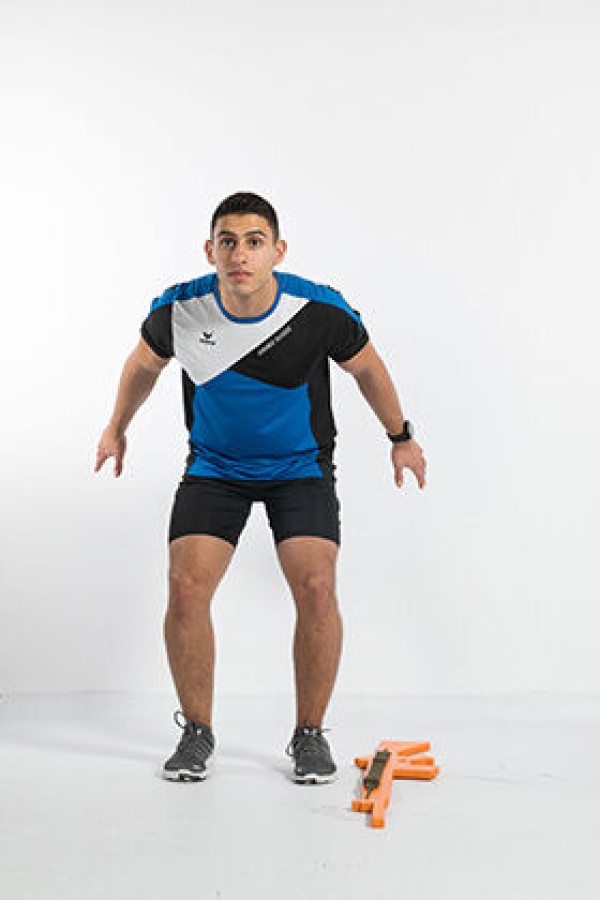

Assault rifle lying flat on the ground or placed on the bipod rest. Stand upright next to the weapon, facing in the direction of travel, and then perform two-legged jumps sideways over the rifle.
Lighten:
With the rifle resting on the bipod support, perform deeper jumps closer to the butt.
Harden:
Rifle placed on the bipod rest: perform higher jumps over the barrel.
Variant:
Launch/land with the leg facing away from the assault rifle (single-leg jumps).
1 assault rifle (neutralised)
One-legged jump to the side
Power
Individual work
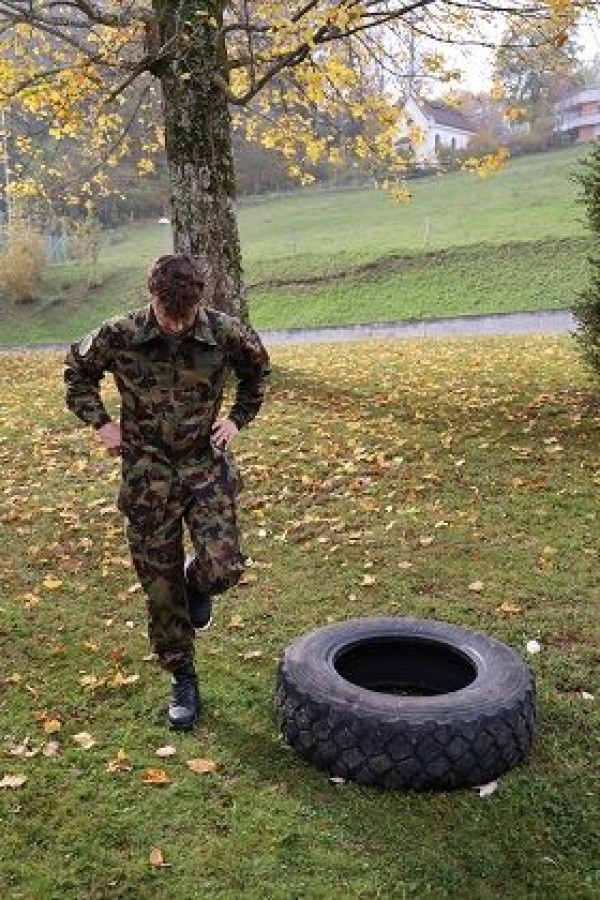
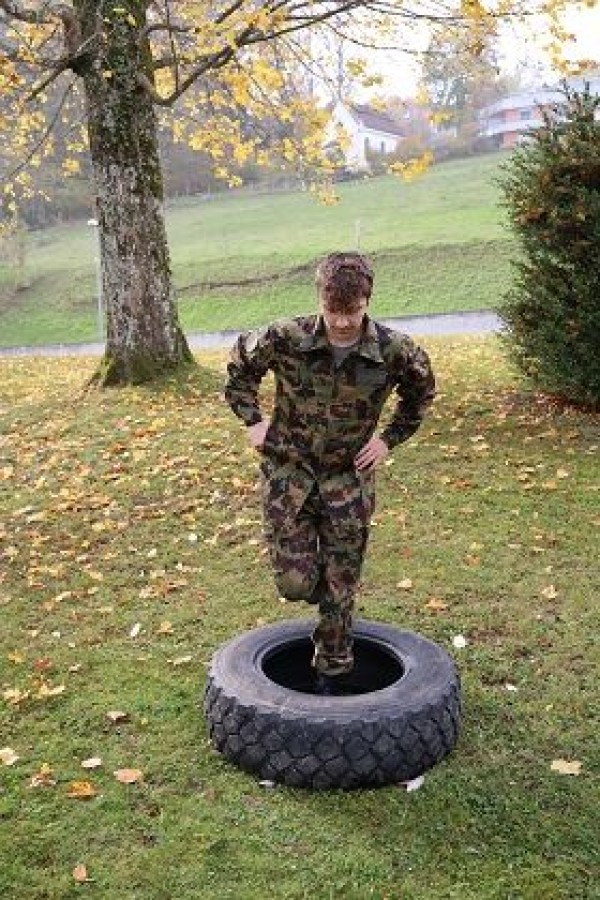
Stand on one leg outside the object (e.g. tyre) with the leg slightly bent. Tilt your upper body slightly forwards and jump onto the other leg inside the object and then jump back to the starting position.
Attention:
Risk of tripping.
Keep your knees stable and always behind your toes.
Lighten:
Jump without an object; jump over an object (e.g. combat backpack or helmet); lower cadence.
Harden:
Higher cadence; additional weight (on the feet).
1 tyre (10DM)
1 combat backpack/helmet ► make the exercise easier
2 weight cuffs/1 weight waistcoat ► make the exercise more difficult (additional weight)
One-legged jump to the side ► skater jump
Power
Individual work
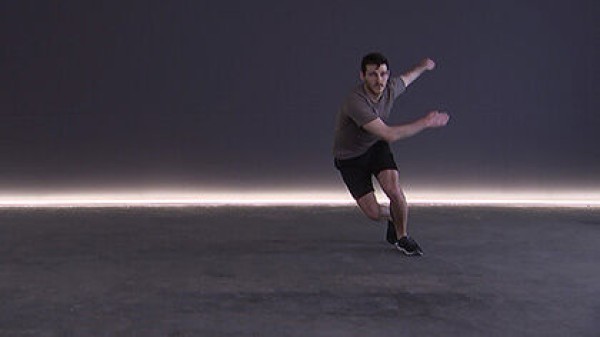

Stand on one leg with the leg slightly bent. Tilt your upper body forwards slightly and jump sideways onto the other leg. Hold your balance briefly in this position and then jump back to the other side.
Attention:
Keep your knees stable and always behind your toes.
Lighten:
Bend your knees less (greater angle); jump less to the side.
Harden:
Bend your knees more (smaller angle); hold additional weight (on your legs, shoulders, in front of your chest or in your hands).
2-4 weight cuffs/2 weight balls/dumbbells/1 weight vest/weight disc/sandbag/fighting rucksack ► Make the exercise more difficult (additional weight)
Jump roll from a standing position
Floor and apparatus gymnastics












Both legs jump from a standing position with a slight forward lean (centre of gravity in front of the feet), slightly bent posture (C+) with body tension in the flight phase, arms stretched out in a high hold, hands placed shoulder-width apart, arms bent, head pulled towards the chest when rolling down (resting on the neck), squatting and standing up (without using the hands).
Variant:
Jump roll over a vaulting box element or the crouching partner.
The participants practise the movement form independently using series of pictures or based on the demonstration of the exercise by the instructor. The instructor (or a partner) gives feedback, provides support and checks the correct execution.
4 soft mats (small) ► indoor version
1 row
outdoor:
turf field
Relay
Forms of play / exercises
Group work
4-5 participants per group
A runner carries a ball in their hands and runs around a turning point (e.g. colouring stick, marker cone or cone) or to the hall wall and back before sending the next runner onto the track. Several runs are chosen per participant with different forms of locomotion (e.g. normal sprint, one-legged hopping on the right and left leg, running backwards).
Replacements: Run to the end of the waiting group: pass the ball forwards over the heads of participants - pass the ball forwards between the legs - pass the ball alternately over the head and between the legs
.Per group:
2 colouring sticks
1 ball (volleyball, softball)
Relay
Forms of play / exercises
Group work
4-5 participants per group
One runner runs around a turning point (e.g. colouring stick, marker cone or cone) or to the hall wall and back before sending the next runner onto the course. The course can be completed as follows:
- Balancing the ball on the racket
- Juggling the ball with the racket
- Bouncing the ball on the floor
- Rolling/guiding the ball along the floor
Returns: From a defined line, a pass is played to the next participant in the group, who catches the ball with the racket without it falling to the ground (until successful or a maximum of three attempts) - run behind the group and pass the ball forwards between the legs - pass the ball behind the starting line with the racket (without hands).
Per group:
2 colouring sticks
1 Smolball
Per participant:
1 Smolball bat
Relay
Forms of play / exercises
Group work
4-5 participants per group
One runner jumps with the skipping rope around a turning point (e.g. painting stick, marker cone or cone) or to the hall wall and back before handing the skipping rope to the next runner and sending them on their way. There are different ways of moving with the skipping rope to complete the course:
Single run:
- Skipping rope: right leg first only (with/without intermediate step)
- Skipping rope: left leg first only (with/without intermediate step)
- Skipping rope: alternating right/left leg first (with/without intermediate step)
- Skipping rope: two-legged
- Skipping rope: one-legged left
- Skipping rope: one-legged right
- Skipping rope: walking backwards
- Skipping rope between the knees
Note: if you make a mistake, return to the start or turnaround, but after 3 mistakes you can continue jumping in place. The forms of locomotion can also be combined (e.g. outward one-legged left - return one-legged right, outward two-legged - return sprint without jumping rope).
Per group:
2 colouring sticks
1 skipping rope
Relay race
Basic training
Group work
Groups of 4
Relay race in teams of 4 in the arena: Each group appoints a starting runner who carries a handover stick/ribbon or similar. A runner from each team stands ready in each corner. The starting runner completes the first part of the course before handing over the baton/ribbon to the next runner, who in turn hands over the relay item to the next runner, etc. The starting runner has the task of handing over the baton/ribbon to the next runner. The starting runner has the task of counting how many times he/she has returned to the starting point in the specified time (number of laps). The sports director starts 2 runs of 9 minutes each with a break of 1-2 minutes between the runs (change of direction). The team goal for the second round is to complete more laps than in the first round.
Course: square (max. size of a football pitch). size of a football pitch)
Intensity level: 3 (medium)
HFmax: 80-90%
Speech rule: speak in full sentences
Variant:
The participants run at different speeds (e.g. participant A: intensity 3; participant B: intensity 2).
4 marking cones/caps
1 handover stick/tape
Sports manager:
1 stopwatch
Standing and prone position alternating
Power
Individual work


From the standing position, assume the prone position freely, observing the correct stance (see regulation 53.103: bend both knees simultaneously; kneel on the line of the hips; bend the upper body forwards and catch it with the weak hand; lie down without the weapon touching the ground, weapon and body form a line). Then stand up (reverse sequence of movements) and return to the standing position.
Attention:
The weapon is always pointed forwards.
1 pistol (neutralised)
Standing and prone position alternating
Power
Individual work



From the standing position, assume the prone position freely, observing the correct stance (see regulation 53.096: bend both knees simultaneously; kneel on the line of the hips; bend the upper body forwards and catch it with the weak hand; lie down so that the weapon and the body form a line). Then stand up (reverse movement sequence) and return to the standing position.
Attention:
The weapon is always pointed forwards.
1 assault rifle (neutralised)
Alternating standing and crouching position
Power
Individual work


From the standing position, assume the crouching position, observing the correct stance (see regulation 53.096: bend both knees evenly, squat down; place feet flat on the ground; strike the weapon; both elbows are placed in front of the knees; the body is tilted slightly forwards). Then straighten up by stretching your legs and return to the standing position.
Attention:
The weapon is always pointed forwards.
1 assault rifle (neutralised)
Standing and kneeling position alternating
Power
Individual work


From the standing position, take up the position kneeling (on one knee), observing the correct stance (see regulation 53.103: take a step forwards with the weak leg over an imaginary line pointing from the tip of the strong foot to the target; bend both knees simultaneously; sit on the strong heel; bend the strong knee 45° from the direction of the shot; rest the weak elbow in front of or behind the weak knee). Then stand up by pushing off the front foot and return to the standing position.
Attention:
Weapon is always pointed forwards.
1 pistol (neutralised)
Standing and kneeling position alternating
Power
Individual work
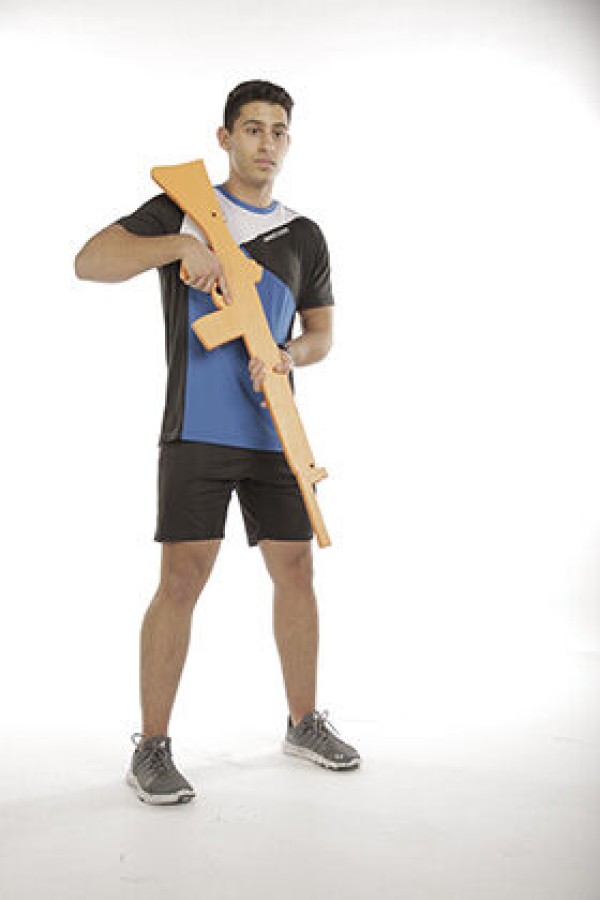

From the standing position, assume the kneeling position, observing the correct stance (see regulation 53.096: take a step forward in front of the strong leg with the weak leg, crossing the imaginary line from the strong leg to the target; bend both knees simultaneously, sit on the strong heel; the strong knee is bent 45 degrees from the direction of the shot; support the weak elbow slightly in front of or behind the weak knee). Then stand up by pushing off the front foot and return to the standing position.
Attention:
The weapon is always pointed forwards.
1 assault rifle (neutralised)
Standing and kneeling alternately
Power
Individual work


From the standing position, assume the kneeling position (on both knees), observing the correct stance (see regulation 53.103: starting position is the standing position; straighten the back and bend both knees at the same time; go to the ground with both knees). Then return to the standing position.
Attention:
The weapon is always pointed forwards.
1 pistol (neutralised)
Standing and supine position alternating (left) ► turkish get up
Power
Individual work






From the lying position (supine position), you move through various intermediate positions to the upright position, whereby the main focus is on holding the weight (dumbbell or kettlebell) in one hand overhead in a stable position and always working with a stretched back.
As a starting position, the weight is held in a supine position with one arm (left) almost outstretched at chest height (arm pointing upwards), the leg (left) on the same side where the weight is held is bent (foot placed on the floor). Firstly, the shoulders are lifted using the forearm of the arm resting on the floor (right). Then rest the free arm on the hand to lift the whole upper body away from the floor. The hips are then pushed upwards and the outstretched leg (right) is pulled under the body and brought backwards into a kneeling position (half kneeling position with one hand resting on the floor). The arm that is currently still supporting you (right) is then finally lifted off the floor to a half-kneeling position with the upper body upright. A lunge is used to assume the final standing position. Reverse the sequence of movements to return to the starting position lying on the floor.
Starting position:
- Supine position
- Leg bent and positioned on the side of the weight
- Weight held in front of you with one arm almost straight (arm pointing firmly upwards)
- Abdominal and gluteal muscles are tensed
- Gaze is directed towards the weight
Final position:
- Stand upright with a straight back
- Stabilise the weight overhead with an almost outstretched arm
Attention:
This exercise places extremely high demands on mobility and stability, which is why it is only suitable for advanced exercisers. Distribute the weight over the entire foot during the movement sequence
1 dumbbell/kettlebell
Standing and supine position alternating (left) ► turkish get up
Power
Individual work
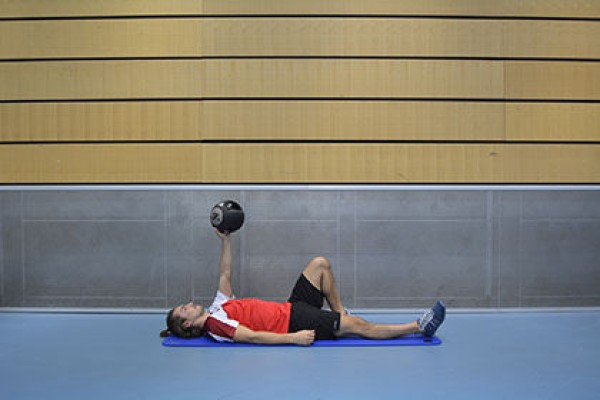



From the lying position (supine position), you move through various intermediate positions to the upright position, whereby the main focus is on holding the weight (dumbbell or kettlebell) in one hand overhead in a stable position and always working with a stretched back.
As a starting position, the weight is held in a supine position with one arm (right) almost outstretched at chest height (arm facing upwards), the leg (right) on the same side where the weight is held is bent (foot on the floor). Firstly, the shoulders are lifted using the forearm of the arm resting on the floor (left). Then rest the free arm on the hand to lift the whole upper body away from the floor. The hips are then pushed upwards and the outstretched leg (left) is pulled under the body and brought backwards into a kneeling position (half kneeling position with one hand resting on the floor). The arm that is currently still supporting you (left) is then finally lifted off the floor to a half-kneeling position with the upper body upright. A lunge is used to assume the final standing position. Reverse the sequence of movements to return to the starting position lying on the floor.
Starting position:
- Supine position
- Leg bent and positioned on the side of the weight
- Weight held in front of you with one arm almost straight (arm pointing firmly upwards)
- Abdominal and gluteal muscles are tensed
- Gaze is directed towards the weight
Final position:
- Stand upright with a straight back
- Stabilise the weight overhead with an almost outstretched arm
Attention:
This exercise places extremely high demands on mobility and stability, which is why it is only suitable for advanced exercisers. Distribute the weight over the entire foot during the movement sequence
1 dumbbell/kettlebell
Standing and supine position alternating (right) ► turkish get up
Power
Individual work
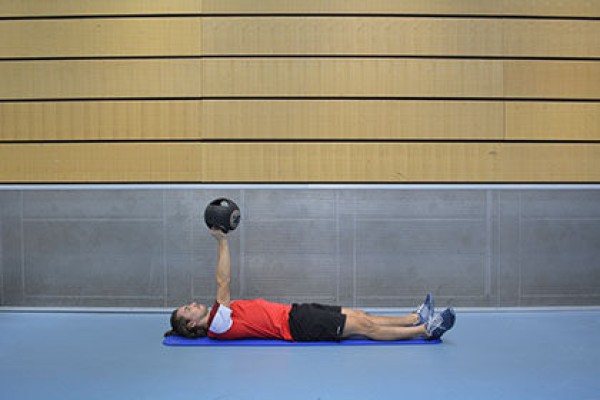


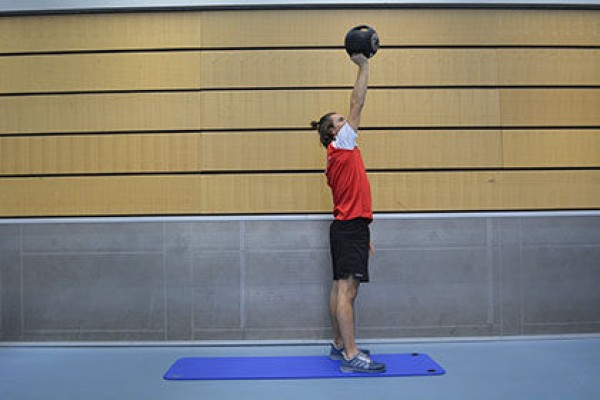
From the lying position (supine position), you move through various intermediate positions to the upright position, whereby the main focus is on holding the weight (dumbbell or kettlebell) in one hand overhead in a stable position and always working with a stretched back.
As a starting position, the weight is held in a supine position with one arm (right) almost outstretched at chest height (arm facing upwards), the leg (right) on the same side where the weight is held is bent (foot on the floor). Firstly, the shoulders are lifted using the forearm of the arm resting on the floor (left). Then rest the free arm on the hand to lift the whole upper body away from the floor. The hips are then pushed upwards and the outstretched leg (left) is pulled under the body and brought backwards into a kneeling position (half kneeling position with one hand resting on the floor). The arm that is currently still supporting you (left) is then finally lifted off the floor to a half-kneeling position with the upper body upright. A lunge is used to assume the final standing position. Reverse the sequence of movements to return to the starting position lying on the floor.
Starting position:
- Supine position
- Leg bent and positioned on the side of the weight
- Weight held in front of you with one arm almost straight (arm pointing firmly upwards)
- Abdominal and gluteal muscles are tensed
- Gaze is directed towards the weight
Final position:
- Stand upright with a straight back
- Stabilise the weight overhead with an almost outstretched arm
Attention:
This exercise places extremely high demands on mobility and stability, which is why it is only suitable for advanced exercisers. Distribute the weight over the entire foot during the movement sequence
1 dumbbell/kettlebell
Standwaage
Floor and apparatus gymnastics






Stepping position with a secure stance on the standing leg, rear leg only on tiptoe, arms held high, rear leg lifted backwards and upwards, upper body simultaneously tilted forwards, gaze directed forwards, arms stretched out to the side, rear foot raised at least to head height, standing leg stretched, body firmly tensed.
The participants practise the movement independently using series of pictures or based on the instructor's demonstration of the exercise. The instructor (or a partner) gives feedback, provides support and checks that the exercise is being performed correctly.
2 soft mats (small) - optional ► indoor version
1 row
outdoor:
turf field
Standwaage
Power
Individual work




Stand upright, facing the chair. At the same time, tilt your upper body forwards (keep your upper body horizontal to the floor) and raise your practically stretched free leg up to the height of your buttocks. To keep your balance better, support your upper body with your arms on the seat of the chair. In the end position, the leg and upper body are roughly in line. The position in the shape of the letter "T" is also known as the standing balance. Then raise the upper body and lower the leg back to the starting position. Switch sides after each execution (change the supporting leg/playing leg).
Attention:
Keep your back straight at all times (tense your torso), distribute your weight over the entire foot (supporting leg).
1 (office) chair
Standing scale (left)
Power
Individual work
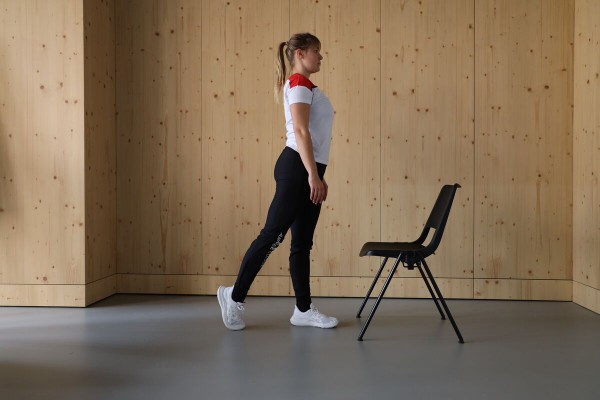
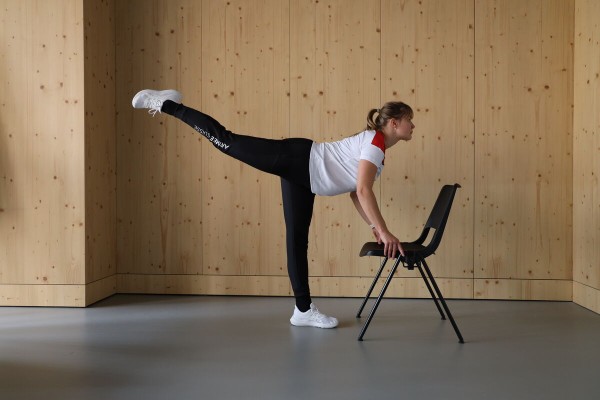
Stand upright, slightly offset, with the free leg (right) slightly further back than the supporting leg (left) and facing the chair. At the same time, tilt the upper body forwards (keep the upper body horizontal to the floor) and raise the practically stretched free leg to the height of the buttocks. To keep your balance better, support your upper body with your arms on the seat of the chair. In the end position, the leg and upper body are roughly in line. The position in the shape of the letter "T" is also known as the standing balance. Then raise your upper body and lower your leg back to the starting position.
Attention:
Keep your back straight at all times (tense your core) and distribute your weight over your entire foot (standing leg).
1 (office) chair
Standwaage (right)
Power
Individual work


Stand upright, slightly offset, with the free leg (left) slightly further back than the supporting leg (right) and facing the chair. At the same time, tilt the upper body forwards (keep the upper body horizontal to the floor) and lift the practically stretched free leg up to the height of the buttocks. To keep your balance better, support your upper body with your arms on the seat of the chair. In the end position, the leg and upper body are roughly in line. The position in the shape of the letter "T" is also known as the standing balance. Then raise your upper body and lower your leg back to the starting position.
Attention:
Keep your back straight at all times (tense your core) and distribute your weight over your entire foot (standing leg).
1 (office) chair
Star run
Orienteering
Single run or 2/3 groups
The sports director distributes the controls in the area in advance, which the participants run to individually or in small groups during the star run. The start is the centre of the run, where the participants also receive the control overview and the running map. Each control is approached individually (in a star shape) (e.g. clockwise/counter-clockwise or in any order). After each control, the runners return to the centre before moving on to the next control. For control purposes, the sports director visually checks each control so that several controls are not stamped in one run. The star run can be run as a practice run or as a competition. A relay is not necessary as not all participants are likely to start in the same direction. For the star run, each participant/group has a defined amount of time to find as many or as many posts as possible.
Variant I:
Prepare the post transfer point: The participants do not receive a map on which the controls are already marked, but must mark the controls themselves at a control transfer point (e.g. using coordinates, azimuth or measuring point method). The control sheets remain at the start even after the transfer. Before the participants set off on the course, the sports director checks the marked controls.
Variant II:
The first control is marked on the course map so that the participants can start in all directions.
Orienteering controls (to be unplugged)
1 (stop) watch
Participant/group:
1 orienteering map with control overview incl. designation (prepared in advance by the sports leader)
1 running map form 30.063
1 bus pole
Variation of the exercise:
Participant/group:
1 control transfer sheet
1 map scale
1 pencil and eraser
Stubborn buck
Fighting and roughhousing games
Partner work
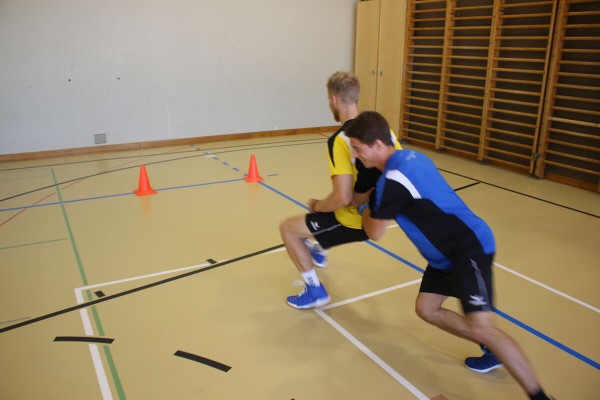
Two participants stand behind each other and look in the same direction. The person behind now tries to push the person in front over a previously agreed line. The roles are then switched.
Variant:
Stop time until the line is crossed.
2 marking cones/caps (optional) ►Field markings
1 stopwatch ►Variation of the exercise
Post setup:
Place caps on a defined baseline.
Pushing an object while stationary
Power
Individual work

Push an object lying on the ground (e.g. a tyre) over a certain distance (back and forth). Choose a short distance for multiple pushes (5-10m),
Attention:
Keep your back straight.
Lighten:
Less resistance.
Harden:
More resistance.
1 tyre (DURO)
1 tyre (PUCH) ► Make the exercise easier
1 tyre (10DM) ► Make the exercise more difficult
Pushing an object while stationary
Power
Individual work


Push an inverted vaulting box top including a centre section (possibly filled with medicine balls) over a certain distance (back and forth) (push the bob). Choose a short distance for multiple pushes (5-10m).
Attention:
Keep your back straight.
Lighten:
Less (no) additional weight (medicine balls).
Harden:
Additional weight (medicine balls).
2 vaulting box elements (incl. upper part)
x medicine balls